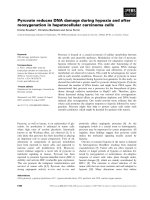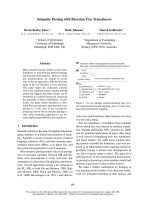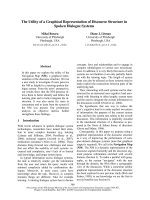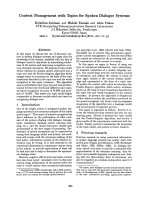Báo cáo khoa học: "Protocolized resuscitation with esophageal Doppler monitoring may improve outcome in post-cardiac surgery patients." ppt
Bạn đang xem bản rút gọn của tài liệu. Xem và tải ngay bản đầy đủ của tài liệu tại đây (57.13 KB, 2 trang )
Available online at
Evidence-Based Medicine Journal Club
EBM Journal Club Section Editor: Eric B. Milbrandt, MD, MPH
Journal club critique
Protocolized resuscitation with esophageal Doppler monitoring may
improve outcome in post-cardiac surgery patients
Mehrnaz Hadian
1
and Derek C. Angus
2
1
Clinical Fellow, Department of Critical Care Medicine, University of Pittsburgh School of Medicine, Pittsburgh, Pennsylvania, USA
2
Professor, CRISMA Laboratory, Department of Critical Care Medicine, University of Pittsburgh School of Medicine, Pittsburgh, Pennsylvania, USA
Published online: 28 April 2005
This article is online at
© 2005 BioMed Central Ltd
Critical Care 9: E7 (DOI 10.1186/cc3716)
Expanded Abstract
Citation
McKendry M, McGloin H, Saberi D, Caudwell L, Brady AR,
Singer M: Randomised controlled trial assessing the impact of a
nurse delivered, flow monitored protocol for optimisation of
circulatory status after cardiac surgery. BMJ 2004, 329:258-261
[1].
Hypothesis
Four hours of nurse-led, flow-monitored protocolized
resuscitation reduces complications and shortens stay in
intensive
care and hospital for post-operative cardiac
surgery subjects compared to usual care.
Methods
Design: Randomized controlled trial.
Setting: Intensive care unit and cardiothoracic unit of a
university
teaching hospital between April
2000 and January
2003.
Subjects: 174 adults who had cardiac surgery with
cardiopulmonary bypass. Subjects undergoing off-pump
surgery, aged <18 years, or with relative contraindications
to the use of the esophageal Doppler probe, such as
esophageal disease, were excluded. Subjects were also
excluded postoperatively if on admission to intensive care
there was excessive bleeding, unstable arrhythmias, a need
for intra-aortic balloon counterpulsation, or inotrope
requirements
>10 µg/kg/min of dopamine or dobutamine or
>0.16 µg/kg/min of epinephrine or norepinephrine.
Intervention: Subjects were allocated to conventional
hemodynamic
management (control group) or to an
algorithm guided by esophageal Doppler
flowmetry (protocol
group). An esophageal Doppler probe was inserted within
10 minutes
of arrival in the intensive care unit in both
groups. In the protocol group, the bedside nurse followed an
algorithm that instructed repeated 200 ml colloid boluses
until the stroke volume index no longer increased by >10%
and was
>35 ml/m
2
. Thereafter, the algorithm provided
additional instructions for vasoactive agents based on blood
pressure and stroke volume index (refer to figure 1 in
original article). The algorithm was run until 4 hours post-
probe insertion or until extubation if <4h. In the control
group, probe readings were obtained by a study nurse on
insertion and at four
hours or at extubation if <4h, but the
clinical team was blinded to these
readings. The control
group received standard postoperative care, using markers
of tissue perfusion such as urine
output and arterial base
deficit, and monitoring cardiac output
if clinically indicated.
Outcomes: The primary outcomes were length of stay in
intensive care and hospital. The secondary outcome was
postoperative
complications.
Results
There were 89 subjects in the protocol group and 85 in the
control group with both groups well matched for age, sex,
weight, Parsonnet cardiac risk score, APACHE II score, and
type of surgery. After four hours, protocol subjects had
received a greater volume of colloid (1667 ml vs. 1042 ml,
P<0.001) than control subjects, but the volume of
crystalloids did not differ (353 ml vs. 328 ml, P=0.09).
Protocol subjects saw greater increases in stroke volume
and cardiac output, but no difference in base excess.
Median duration of hospital stay was significantly lower in
the protocol group than the control group (7 days vs. 9
days, P=0.02), though ICU length of stay did not differ.
There was a trend toward fewer postoperative complications
in the protocol group (19.1% vs. 30.6%, P=0.08).
Conclusion
A nurse-delivered protocol to optimize circulatory
status in
the early postoperative period after cardiac surgery
may
significantly shorten hospital stay.
Critical Care August 2005 Vol 9 No 4 Hadian and Angus
Commentary
Use of esophageal Doppler monitoring (EDM) during
surgery has previously been shown to be associated with
improved end-organ perfusion and/or reduced length of stay
[2-5]. The current study by McKendry and colleagues differs
in that none of the previous studies were performed in an
ICU setting using a nurse-delivered protocol.
This study was a well-designed randomized controlled trial.
The two groups were similar at baseline, suggesting
randomization was successful, and the results seem to
argue strongly in favor of the protocolized arm. The
intervention is attractive for a number of reasons. First, in
comparison to reliance on clinical markers alone, EDM
offers an assessment of central hemodynamics. Second,
compared to the traditional measure of central
hemodynamics, the pulmonary artery catheter, EDM is less
invasive, it provides continuous ‘beat-to-beat’ cardiac output
monitoring, and it measures flow rather than pressure,
which is probably a better indicator of tissue perfusion [6,7].
Third, the intervention is not just EDM. Rather, it is a
protocol relying on information obtained from EDM.
Although earlier studies of EDM have suggested benefit, it
was not possible to delineate from these studies how the
EDM should be used, and it is therefore unclear how others
should apply EDM. The combined protocol plus EDM in the
current study is more easily packaged for export to other
users and settings. Use of EDM by nurses could reduce
costs by minimizing the amount of physician oversight
required.
There are, however, some limitations to this study. First, the
study was a single-center trial performed in a major
university hospital where physician and nursing staff were
familiar with the technique and likely enthusiastic about its
use. The benefits may be less apparent when applied
across a wider cross-section of hospitals by clinicians less
familiar with either the protocol or EDM. Second, it is not
clear if the benefits were due to EDM or the act of
protocolizing resuscitation. It could be that using a
protocolized resuscitation algorithm with other monitoring
techniques (perhaps even clinical examination) could yield
similar benefits. Third, the standard care provided in the
control arm is difficult to quantify. Care might have been
less intense with respect to routine care than in other
institutions. Alternatively, there could be contamination bias
between arms, resulting in more aggressive monitoring and
intervention in the control arm, and an underestimation of
treatment effect. All these limitations can be addressed in a
larger multicenter evaluation. In this respect, this study
could be considered analogous to a very promising phase II
study of a potential new drug, meriting a subsequent phase
III follow-up study.
Finally, it remains tantalizing to speculate on why this
approach improved outcome. Although it seems intuitive
that aggressive monitoring and resuscitation in situations of
occult shock and hypoperfusion should be beneficial,
studies have yielded inconsistent results. It would be
interesting to know in what ways the intervention arm in this
study affected the pathophysiology of shock and
hypoperfusion. For example, was there less ischemia,
oxidative stress, inflammation, or activation of coagulation
and thrombosis pathways? Ultimately, it seems we still need
to understand how our therapies manipulate the basic
pathways implicated in critical illness in the clinical setting if
we are to develop optimal titrated care.
Recommendation
Until more information is available, we cannot recommend
widespread adoption of EDM outside the clinical research
arena. Nevertheless, the results strongly merit the conduct
of a confirmatory trial, along with evaluation of the impact of
this intervention on other endpoints. Furthermore,
protocolized resuscitation with EDM may have benefits in
other conditions where there is significant risk of under-
resuscitation, such as other postoperative groups and
subjects with sepsis, burns, or trauma.
Competing interests
The authors declare that they have no competing interests.
References
1. McKendry M, McGloin H, Saberi D, Caudwell L, Brady AR,
Singer M: Randomised controlled trial assessing the
impact of a nurse delivered, flow monitored protocol
for optimisation of circulatory status after cardiac
surgery. BMJ 2004, 329:258-261.
2. Gan TJ, Soppitt A, Maroof M, el Moalem H, Robertson KM,
Moretti E, Dwane P, Glass PS: Goal-directed
intraoperative fluid administration reduces length of
hospital stay after major surgery. Anesthesiology 2002,
97:820-826.
3. Mythen MG, Webb AR: Intra-operative gut mucosal
hypoperfusion is associated with increased post-
operative complications and cost. Intensive Care Med
1994, 20:99-104.
4. Mythen MG, Webb AR: Perioperative plasma volume
expansion reduces the incidence of gut mucosal
hypoperfusion during cardiac surgery. Arch Surg 1995,
130:423-429.
5. Sinclair S, James S, Singer M: Intraoperative
intravascular volume optimisation and length of
hospital stay after repair of proximal femoral fracture:
randomised controlled trial. BMJ 1997, 315:909-912.
6. Lefrant JY, Bruelle P, Aya AG, Saissi G, Dauzat M, de la
Coussaye JE, Eledjam JJ: Training is required to
improve the reliability of esophageal Doppler to
measure cardiac output in critically ill patients.
Intensive Care Med 1998, 24:347-352.
7. Valtier B, Cholley BP, Belot JP, de la Coussaye JE, Mateo
J, Payen DM: Noninvasive monitoring of cardiac output
in critically ill patients using transesophageal Doppler.
Am J Respir Crit Care Med 1998, 158:77-83.









